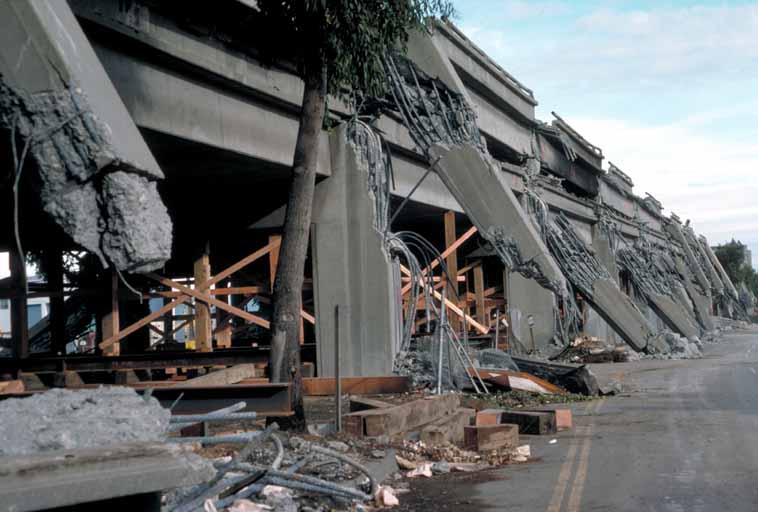I was in a car in the East Bay and did not feel it. You had
to be darned close to the epicenter to feel it in a moving car. Santa Cruz
county residents later told me stories of pulling over to check their
"flat tire," and then noticing everyone else seemed to have a flat
tire, too--by that time the shaking was over but, being Californians, they
figured it out pretty quickly. I felt nothing until the car hit a chunk of
collapsed roadway a half-hour later and my teeth clacked together as the car
bottomed out. (That section of road was closed an hour later and stayed closed
for months.) I began to get suspicious about the lack of lights--either fog had
really socked in the area ahead of me, or something was wrong. The car radio
told me what.
The Bay Bridge was broken, so getting to my flat in the city
required a strange route home, but I got there before three hours had passed.
Everything on the north and south walls had fallen down, and kitchen drawers on
those walls had shaken themselves open. The pets weren't sure they were ever
coming out from under the bed, thank you very much, but once I knew they were
alive, I felt calmed. (Food soon convinced them it was a good idea to rejoin
society.) Cleaning up would have to wait for lights, power, and the next day.
One of the worst thoughts in a ~7.0 quake is "maybe
that was just the foreshock." It's not a happy thought as tiny tremors
keep rattling your home--and I have to say, that was the worst bit of trauma I
experienced, and it really doesn't qualify as trauma...just edginess that faded over the months.
If you were alive and watched TV news about the event, you'd
have thought that the city burned for days. A part of one block burned for a
couple hours, and yet the same image was replayed steadily to scare viewers,
keep them glued to the set, and hey, now it's commercial break, and come and
buy this piece of junk you don't really need while your emotions are overriding your logic. Our collective awareness of the
manipulations of "news" changed in The City that week. News is
new--and perhaps useful--for a few hours; after that, it's too much speculation and
subtle lies. We were back at work, everyone had power, everything was picked up
but the wrecked highways, and according to the news, we were still in the midst
of an active disaster.
The Oakland highway collapse was nasty, and it
accounted for most of the deaths. The benefit to that is highways are designed
differently now (small comfort to relatives of the victims, I'm sure). A 9.0 would still take several down, but for the most part,
you can drive with more confidence on California's highways than on highways
anywhere else--though Japan's are at least as well-built.
 |
| Cypress freeway 10/19/1989 |
I learned two small but useful lessons: bolt your bookcases
and china/curio cases to the wall studs, and get earthquake museum gel for your
breakables, an easy ounce of prevention. If you live
anywhere on planet Earth, you can experience a quake. If you live in the New
Madrid Seismic Zone, California, Alaska, Japan, New Zealand, you'd be wise to
be well-prepared...and to trade in your brick home for a frame one, ASAP. Seriously, brick is a bad,
bad building idea for earthquake zones. Remember, 63 people died in the Loma Prieta quake; over 100,000 died in a quake of the same magnitude in Haiti. Buildings are what kill people in quakes.
In most ways, I'm glad I had that experience. It certainly helped me to make my earthquake novel more realistic. My worst
trauma today is seeing it is 25 years ago--man, that means I'm getting old!
;) I hope to be around to talk about it again at the 50th anniversary.


No comments:
Post a Comment
moderated twice a week, so please be patient!